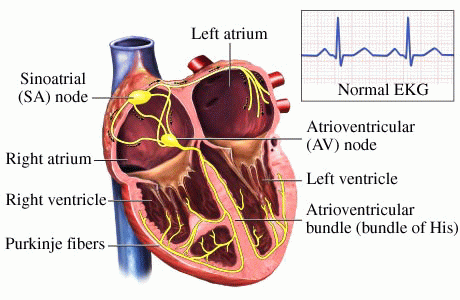THE HEART
The Electrical System of the Heart

How does the heart’s electrical system work?
An electrical stimulus is generated by the sinoatrial (SA) node, the heart’s natural pacemaker. This is a small area of specialized tissue located in the right atrium (right upper chamber) of the heart. Under normal conditions, the sinus node generates an electrical stimulus every time the heart beats (60 to100 times per minute for an adult). This electrical stimulus travels down through the conduction pathways (similar to the way electricity flows through power lines from the power plant to your house) and causes the heart’s chambers to contract and pump out blood. The right and left atria (the two upper chambers of the heart) are stimulated first and contract a short period of time before the right and left ventricles (the two lower chambers of the heart).
The electrical impulse then travels from the SA node to the atrioventricular (AV) node, where it stops for a very short period, and continues down the conduction pathways via the bundle of this into the ventricles. The bundle of His divides into right and left pathways to the purkinje fibres that provide electrical stimulation to both ventricles.
Normally, the electrical impulse moves through the heart’s conduction system, and the heart contracts. Each contraction represents one heartbeat. The atria contract a fraction of a second before the ventricles so the blood empties into the ventricles before the ventricles contract.
Under some conditions, almost all heart tissue is capable of starting a heartbeat, or becoming the ‘pacemaker’, just like the SA node. This is called a dysrhythmia (or arrhythmia) and may occur when:
The heart’s natural pacemaker (the SA node) develops an abnormal rate or rhythm. the normal conduction pathway is interrupted. another part of the heart takes over
as pacemaker.
More: Source of the Heartbeat – Enlightenment of the Whole Body